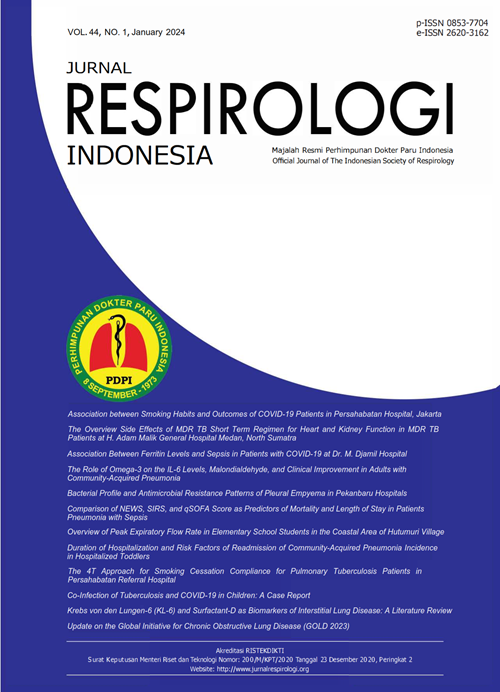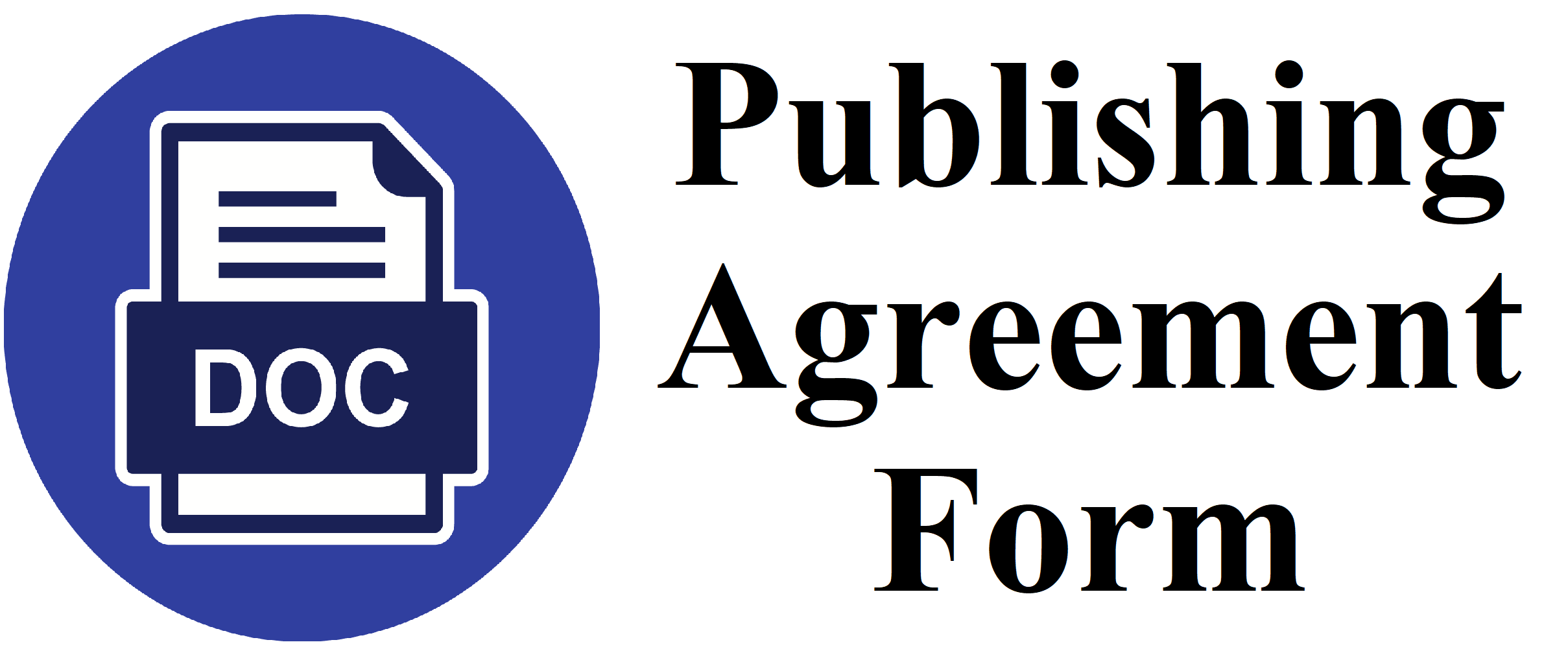The Overview Side Effects of MDR TB Short Term Regimen for Heart and Kidney Function in MDR TB Patients at H. Adam Malik General Hospital Medan, North Sumatra
DOI:
https://doi.org/10.36497/jri.v44i1.573Keywords:
MDR pulmonary tuberculosis, Short term regimen, Prolong QTc, Kidney functionAbstract
Background: World Health Organization issued a recommendation for the use of standard 9–11 month Shorter Multidrug-Drug Resistant Tuberculosis (MDR TB) regimen. It will impact the number of patients treated and improve obedience because of the shorter, low cost, and well-tolerated. However, MDR TB drugs allow side effects both mild, moderate and severe. If severe side effects occur, the patient will stop treatment and close monitoring required. An optimal and adequate care of side effects is the key of the successful of MDR TB treatment. The aim of this study was to determine the side effects that occured in the treatment of MDR TB patients with short term regimen (STR) on heart and kidney function at H. Adam Malik General Hospital Medan, North Sumatra.
Methods: A case series design with a total of 76 MDR TB patients who underwent a shorter regimen. Samples were obtained from the medical record in the pulmonary isolation inward and MDR TB polyclinic at Adam Malik Hospital, Indonesia. Data were analyzed descriptively to identify changes in heart (Prolong QTc) and kidney function of the nine months treatment.
Results: 76 data were collected, the number of male samples was 68.4% and 31.6% were women with the age group of the study subjects being mostly followed by 41-50 years of age. There was a significant increase in value occurred in 4-6 months of treatment related to the side effects of treatment on heart (Prolong QTc) and kidney function.
Conclusion: There was a trend to increase the value of heart (Prolong QTc) and kidney function significantly occurred 4-6 months after the patient underwent MDR TB treatment with STR.
Downloads
References
World Health Organization. Short term regimen for multi drug tesistance TB. Geneva: WHO Press; 2017. 8–20 p.
Perhimpunan Dokter Paru Indonesia. Pedoman diagnosis dan penatalaksanaan tuberkulosis di Indonesia. Jakarta: Badan Penerbit FKUI; 2011. 1–64 p.
Direktorat Jenderal Pencegahan dan Pengendalian Penyakit. Pengobatan pasien TB resistan obat dengan panduan jangka pendek. Jakarta: Kementerian Kesehatan RI; 2017. 1–43 p.
Reis-Santos B, Gomes T, Horta BL, Maciel ELN. The outcome of tuberculosis treatment in subjects with chronic kidney disease in Brazil: a multinomial analysis. J Bras Pneumol. 2013;39(5):585–94.
Yu MC, Chiang CY, Lee JJ, Chien ST, Lin CJ, Lee SW, et al. Treatment outcomes of multidrug-resistant tuberculosis in Taiwan: Tackling loss to follow-up. Clinical Infectious Disease. 2018;
Soeroto AY, Nurhayati RD, Purwiga A, Lestari BW, Pratiwi C, Santoso P, et al. Factors associated with treatment outcome of MDR/RR-TB patients treated with shorter injectable based regimen in West Java Indonesia. PLoS One. 2022;17(1):e0263304.
Gadallah MA, Mokhtar A, Rady M, El-Moghazy E, Fawzy M, Kandil SK. Prognostic factors of treatment among patients with multidrug-resistant tuberculosis in Egypt. J Formos Med Assoc. 2016;115(11):997–1003.
World Health Organization. WHO treatment guidelines for drug-resistant tuberculosis: 2016 update. Geneva: World Health Organization; 2016.
Murray JF, Schraufnagel DE, Hopewell PC. Treatment of tuberculosis: A historical perspective. Ann Am Thorac Soc [Internet]. 2015 Dec 1 [cited 2024 Jan 16];12(12):1749–59. Available from: www.atsjournals.org
World Health Organization. Global tuberculosis control: Surveillance, planning, financing: WHO report 2008. 2008.
International Standards for Tuberculosis Care. TB care I. 3rd ed. The Hague; 2014.
Kurniawati F, Sulaiman SAS, Wasif G. Study on drug-resistant tuberculosis and tuberculosis treatment on patients with drug resistant tuberculosis in chest clinic outpatient department. Int J Pharm Pharm Sci. 2012;4(2):733–7.
Di Gennaro F, Vittozzi P, Gualano G, Musso M, Mosti S, Mencarini P, et al. Active pulmonary tuberculosis in elderly patients: A 2016–2019 retrospective analysis from an Italian Referral Hospital. Antibiotics (Basel). 2020;9(8):489.
Wen Y, Zhang Z, Li X, Xia D, Ma J, Dong Y, et al. Treatment outcomes and factors affecting unsuccessful outcome among new pulmonary smear positive and negative tuberculosis patients in Anqing, China: a retrospective study. BMC Infect Dis. 2018;18(1):104.
Velayutham BRV, Nair D, Chandrasekaran V, Raman B, Sekar G, Watson B, et al. Profile and response to anti-tuberculosis treatment among elderly tuberculosis patients treated under the TB control programme in South India. PLoS One. 2014;9(3):e88045.
Khan F, Ismail M, Khan Q, Ali Z. Moxifloxacin-induced QT interval prolongation and torsades de pointes: a narrative review. Expert Opin Drug Saf. 2018;17(10):1029–39.
Xu FY, Huang JH, He YC, Liang LY, Li LJ, Yang J, et al. Population pharmacokinetics of moxifloxacin and its concentration–QT interval relationship modeling in Chinese healthy volunteers. Acta Pharmacologica Sinica 2017 38:11. 2017;38(11):1580–8.
Jager P de, Altena R van. Hearing loss and nephrotoxicity in long-term aminoglycoside treatment in patients with tuberculosis. Int J Tuberc Lung Dis. 2002;6(7):622–7.
Nathanson E, Gupta R, Huamani P, Leimane V, Pasechnikov AD, Tupasi TE, et al. Adverse events in the treatment of multidrug-resistant tuberculosis: Results from the DOTS-Plus initiative. Int J Tuberc Lung Dis. 2004;8(11):1382–4.
Sturdy A, Goodman A, Joś RJ, Loyse A, O’Donoghue M, Kon OM, et al. Multidrug-resistant tuberculosis (MDR-TB) treatment in the UK: A study of injectable use and toxicity in practice. J Antimicrob Chemother. 2011;66(8):1815–20.
Bloss E, Kuksa L, Holtz TH, Riekstina V, Skripconoka V, Kammerer S, et al. Adverse events related to multidrug-resistant tuberculosis treatment, Latvia, 2000-2004. Int J Tuberc Lung Dis. 2010;14(3):275–81.
Downloads
Published
Issue
Section
License
- The authors own the copyright of published articles. Nevertheless, Jurnal Respirologi Indonesia has the first-to-publish license for the publication material.
- Jurnal Respirologi Indonesia has the right to archive, change the format and republish published articles by presenting the authors’ names.
- Articles are published electronically for open access and online for educational, research, and archiving purposes. Jurnal Respirologi Indonesia is not responsible for any copyright issues that might emerge from using any article except for the previous three purposes.
















